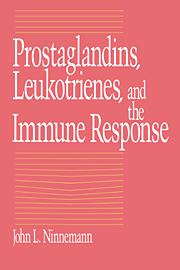Book contents
- Frontmatter
- Contents
- Foreword by James S. Goodwin
- Preface
- 1 A brief history and introduction
- 2 Prostaglandin/leukotriene structure and chemistry: a primer
- 3 Monocytes and macrophages
- 4 Lymphocyte response
- 5 Inflammation and the neutrophil
- 6 Malignancy and the arachidonic acid cascade
- 7 Tissue and organ transplantation
- 8 Rheumatoid arthritis and autoimmunity
- 9 Traumatic injury and surgery
- 10 Allergy
- Index
8 - Rheumatoid arthritis and autoimmunity
Published online by Cambridge University Press: 24 November 2009
- Frontmatter
- Contents
- Foreword by James S. Goodwin
- Preface
- 1 A brief history and introduction
- 2 Prostaglandin/leukotriene structure and chemistry: a primer
- 3 Monocytes and macrophages
- 4 Lymphocyte response
- 5 Inflammation and the neutrophil
- 6 Malignancy and the arachidonic acid cascade
- 7 Tissue and organ transplantation
- 8 Rheumatoid arthritis and autoimmunity
- 9 Traumatic injury and surgery
- 10 Allergy
- Index
Summary
Rheumatoid arthritis is a chronic inflammatory disease involving the joints and connective tissues throughout the body. The disease is most common in females between the ages of 30 and 40 years, and has a generally unpredictable course. The etiology of rheumatoid arthritis is still unknown; however, there is evidence that immune complexes are involved in the pathogenesis of the synovial lesions characteristic of the disease. These antigen–antibody complexes can activate complement, a process which releases chemotactic factors and attracts granulocytes. The granulocytes release lysosomal enzymes and vasoactive amines and cause inflammatory tissue destruction. Complexes consisting of cell nuclear fragments and anti-DNA antibodies also contribute to joint inflammation. Antinuclear factors are often present in the joint fluid but absent in the serum. It appears that other diseases, such as gout, spondylitis, psoriatic arthritis, colitic arthritis, and Reiter's syndrome share some of these characteristics (1).
Another hallmark of rheumatoid arthritis is the development and circulation of rheumatoid factor, which is antibody to IgG. Rheumatoid factor includes both 7S and 19S immunoglobulins with specificity to certain determinants on the IgG molecule, determinants thought to be exposed by physical aggregation of IgG or immune-complex formation (2). Rheumatoid factor can be detected in the serum of approximately 80% of patients with rheumatoid arthritis (3) and can also be seen in many nonrheumatoid diseases including viral and parasitic infections, tuberculosis, leprosy, and subacute bacterial endocarditis (4).
- Type
- Chapter
- Information
- Prostaglandins, Leukotrienes, and the Immune Response , pp. 157 - 170Publisher: Cambridge University PressPrint publication year: 1988



